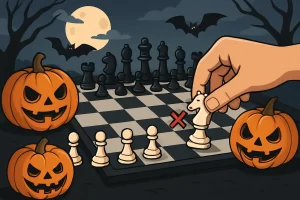Call us now:

When you sit down at the chessboard and take up the mantle of the black pieces, you’ve got a decision to make long before you hit the clock. What’s your approach to the opening phase? Do you strike back with venomous counterplay or dig into a fortress that would impress Magnus Carlsen’s deepest preparation? For Black, opening choices define the identity of your game — from razor-sharp counterattacks to suffocating positional frameworks.
This isn’t just a listicle of random openings. It’s a guided journey through tried-and-tested chess openings for Black — tailored for real players, with real goals. We’ll explore the most playable, aggressive, reliable, and strategic defensive systems from Black’s side. Whether you’re facing 1.e4 or 1.d4, whether you’re a stonewall defender or a firebrand tactician, this is your black-side playbook.
Let’s break open the vaults.
Table of Contents
- The Psychology of Playing Black
- The Four Pillars of Black Opening Strategy
- Best Chess Openings for Black Against 1.e4
- Sicilian Defense
- Caro-Kann Defense
- French Defense
- Modern Defense
- Best Chess Openings for Black Against 1.d4
- Nimzo-Indian Defense
- King’s Indian Defense
- Slav and Semi-Slav Defenses
- Queen’s Gambit Declined
- Aggressive Chess Openings for Black
- Solid Defensive Options for Black
- Chess Openings for Black Beginners
- What Grandmasters Play — and Why
- Key Takeaways & Progression by Skill Level
- Conclusion: Crafting Your Black Repertoire
The Psychology of Playing Black
Let’s clear one thing up straightaway: playing Black is not playing second fiddle.
Yes, White moves first, but Black chooses the script. Will you allow White to dictate the center, or will you wrench the initiative away with deeply researched preparation? Black openings demand resilience, counterpunch accuracy, and strategic commitment from move one.
Top-level players often aim for sharp equality — not just to survive White’s push but to punish any small slip. And in club and online play, many victories as Black come from cornering overconfident White players who overextend early.
Understanding the psychology of space, initiative, and timing gives Black players a hidden edge. You’re not reacting. You’re setting traps, springing surprises, and dragging the game into your preferred territory.
The Four Pillars of Black Opening Strategy
Before diving into specific lines, every strong chess player should understand these core themes of Black strategy:
| Pillar | Description | Common in Openings Like |
|---|---|---|
| Counterattack | Let White overextend, then strike | Sicilian, Modern Defense |
| Solid Structure | Control key squares with pawn walls | Caro-Kann, Slav |
| Piece Play | Prioritize fast, active development | King’s Indian, Nimzo-Indian |
| Central Locks | Fight for space or construct blockades | French Defense, Queen’s Gambit Declined |
Choose an opening that aligns with your style. You want to feel both comfortable and dangerous — like walking into dark territory you know better than your opponent.
Best Chess Openings for Black Against 1.e4
Let’s begin with the most played opening move in chess: 1.e4. Your responses as Black define whole families of play, from the blood-soaked battlegrounds of the Sicilian to the stubborn gates of the French. Here’s what to pack in your arsenal.
♜ Sicilian Defense (1.e4 c5)
Style: Aggressive counterattacking
Difficulty: Intermediate to advanced
Used by: Fischer, Kasparov, Anand, Carlsen
The Sicilian Defense is not polite. It’s predatory. While White opens with central dreams after 1.e4, the Sicilian flanks them with 1…c5 and declares war on d4 — not today.
Black immediately unbalances the game and draws White into murky waters where nuanced preparation can turn into bloodbaths.
Popular Variations:
- Najdorf (5…a6) – Legendary for its depth and tactical fury
- Dragon (g6 + …Bg7) – Searing pressure down the long diagonal
- Scheveningen – Flexible, solid, perfect for hybrid systems
- Sveshnikov – Sharp theoretical mess that works well in blitz to classical
This is not an opening you dabble in casually. But once you invest the study time, the Sicilian becomes a fortress drenched in traps.
“Against e4, I play the Sicilian. It is the most combative response. You are not playing for equality. You want to win.” — Garry Kasparov
♜ Caro-Kann Defense (1.e4 c6)
Style: Solid, rock-like positional
Difficulty: Beginner-friendly, GM-tested
Used by: Karpov, Carlsen, Petrosian
The Caro-Kann doesn’t seek early aggression but builds an unshakable foundation. Its appeal? Simplicity… and depth. After 1.e4 c6 2.d4 d5, Black calmly challenges the center and sets up a lasting structure.
Common Systems:
- Classical (3.Nc3 or 3.Nd2 dxe4 4.Nxe4 Bf5) – Sound development
- Advanced Variation (3.e5) – A favorite of aggressive White players, but Black has refined counters
- Panov-Botvinnik Attack – Watch out! Sneaky dynamism here for both sides
If you’re tired of collapsing after 10 moves as Black, Caro-Kann is probably what you’re missing.
♜ French Defense (1.e4 e6)
Style: Counterpunching, strategic
Difficulty: Intermediate — structurally complex
Used by: Korchnoi, Short, Mamedyarov
The French Defense is a declaration: “I will not lose quickly. But you might.”
With 1.e4 e6 2.d4 d5, the fight is on. If White pushes with 3.e5, Black builds behind the barricade and aims counter-strikes via …c5 and …f6.
Main Lines:
- Classical (3.Nc3 or 3.Nd2) – Lead you into the enigmatic Winawer or the sneaky Rubenstein
- Advanced (3.e5) – Invites a deeper positional battle and central tension
- Exchange (3.exd5) – Equalish, can become very drawish, but offers attacking chances if White misplays
Patience is key with the French. But once you master its locked pawn grids, your counterattacks become art.
♜ Modern Defense (1.e4 g6)
Style: Hypermodern, unorthodox, traps galore
Difficulty: Intermediate
Used by: Nigel Davies, Tiger Hillarp Persson
Want to unnerve White without memorizing 25 moves of sharp theory?
Enter the Modern Defense. Black allows White to grab the center with pawns, then torments those pawns with pieces.
With setups like …g6, …Bg7, …d6, and waiting moves like …a6 or …c6, you retain maximum flexibility — and inject venom along king-side diagonals.
Suited for psychological warfare and those who love unbalanced positions dripping with opportunities.
Best Chess Openings for Black Against 1.d4
1.d4 initiates a more subdued, slower battle — less open tactics, more strategic maneuvering. But Black has answers ranging from positional masterpieces to dynamic weaponry.
♜ Nimzo-Indian Defense (1.d4 Nf6 2.c4 e6 3.Nc3 Bb4)
Style: Control + activity
Difficulty: Advanced
Used by: Kramnik, Aronian, Ding Liren
In the Nimzo-Indian, Black challenges White’s central dreams early. The pin with …Bb4 is not just harassment — it’s a masterclass in provoking weaknesses and dictating pawn structure.
Why the Nimzo works:
- No early d5 — flexibility remains intact
- Potential to double White’s pawns
- Leads to rich positional options
Be ready to study classic games in this line. The Nimzo isn’t just reactive — it’s the best combination of prophylaxis and aggression Black has to offer.
♜ King’s Indian Defense (1.d4 Nf6 2.c4 g6)
Style: Tactical, high stakes
Difficulty: Advanced
Used by: Fischer, Radjabov, Nakamura
The King’s Indian is for the gladiators.
You’ll watch White build a huge center, smile as pressure mounts, then swing back with …f5, …g5, often under a storm of sacrificial fire. This is the black opening choice for aggressive fighters.
Common lines:
- Classical KID (3.Nf3 Bg7 4.e4 d6 5.Be2 0-0 6.0-0 e5) – The most mainstream
- Saemisch (3.f3) – Sharp! Requires grunt study
- Averbakh, Four Pawns Attack – White tries to bash early; Black must counter-blast
With the King’s Indian, know that you may cede space — but you’re arming for war.
♜ Slav and Semi-Slav Defenses
Slav (1.d4 d5 2.c4 c6)
Semi-Slav (adds …e6 early)
These are among the most respected and resilient answers to d4. Structurally sound, tactically flexible, and a favorite at top levels.
Strengths:
- Minimizes risk
- Deep theoretical backing
- Lots of transpositional opportunities
However, prepare for long middlegames when White chooses slow-building lines. Persistence pays off.
♜ Queen’s Gambit Declined (1.d4 d5 2.c4 e6)
Style: Classical, positionally sound
Difficulty: Beginner to Intermediate
Used by: Capablanca, Anand, Giri
This is the chess educator’s recommendation to beginners who want to learn strategic principles. The Queen’s Gambit Declined (QGD) is simple: Defend the center, develop methodically, and wait for White to blink.
It becomes a proving ground for improving calculation, learning about tension, and mastering long-term planning.
Aggressive Chess Openings for Black
When you’re in the mood to take the fight to your opponent, consider:
| Opening | Aggression Level | Notes |
|---|---|---|
| Sicilian Dragon | Tremendous | Tactical fireworks almost guaranteed |
| King’s Indian Defense | Very High | Sacrifices in closed centers |
| Modern Defense | Tricky | Traps and flexibility overwhelm unprepared foes |
| Budapest Gambit (1.d4 Nf6 2.c4 e5) | High | Offbeat and dangerous; requires preparation |
Aggression is a choice. Study the traps. Embrace the chaos.
Solid Defensive Options for Black
Want to keep it clean, neutralize early pressure, and transition into an equal middle game?
| Opening | Stability Rating | Notes |
|---|---|---|
| Caro-Kann Defense | Excellent | Arguably the most technical yet safe choice |
| French Defense | Great | Strong against reckless White aggression |
| Slav Defense | Rock-Solid | Top-tier endgame transition chances |
Chess Openings for Black Beginners
Start simple. Learn systems, not complex trees:
- Caro-Kann Defense – Easy to understand, very few traps
- Slav Defense – Learn pawn breaks and simple QGD themes
- Queen’s Gambit Declined – Classical structure to grow from
- Scandinavian Defense – Early queen sortie, practical at low levels
Stick with one against e4 and one against d4, and dig deep rather than wide.
What Grandmasters Play — and Why
Pros don’t pick openings randomly:
- Carlsen: Flexible — plays everything, but famous for Caro-Kann and heavy preparation
- Anand: Nimzo, QGD specialist
- Nakamura: King’s Indian when blood’s in the water; Caro-Kann for control
- Fischer: Sicilian devotee — especially the Najdorf
Even at the top, players rotate their black repertoires to remain unpredictable. So should you.
Key Takeaways & Skill Progression Table
| Level | Opening Recommendations | Style |
|---|---|---|
| Beginner | Caro-Kann, QGD, Slav | Simple, safe development |
| Intermediate | French, King’s Indian, Semi-Slav | Balance attack and structure |
| Advanced | Sicilian lines, Nimzo-Indian | Preparation > improvisation |
Conclusion: Crafting Your Black Repertoire
Your repertoire as Black is your identity in the opening. Do you want to counterpunch, absorb, or outwit with traps? The openings we’ve explored aren’t just “responses” to 1.e4 or 1.d4 — they’re invitations to your type of battle.
Build around your personality. Hate long, locked positions? Skip the French. Love explosive tactics? Master the Dragon. Prefer positional play? The Caro awaits you.
Every grandmaster once asked the same questions you face now.
Choose your weapons wisely. Memorize less, understand more. Study classic games. Learn the art of suffering slightly worse positions — and striking back with precision.
Because as any real player knows…
Black doesn’t just dream of equalizing — Black dares to win.
—
Bookmark this guide, digest it over coffee, or bring it to your Blitz training — but remember: your openings should serve your style, not shackle it.



